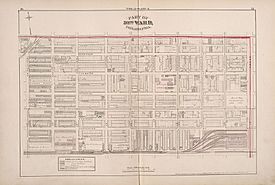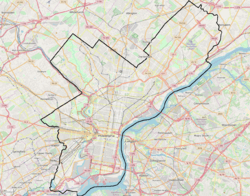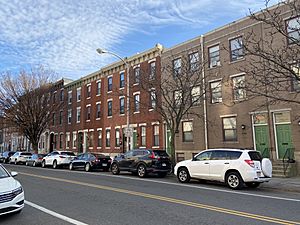Christian Street Historic District facts for kids
Quick facts for kids
Christian Street Historic District
|
|
|---|---|

Street plan of the Christian Street Historic District as it was in 1876
|
|
| Nickname(s):
Black Doctors' Row
|
|
| Country | United States |
| State | Pennsylvania |
| County | Philadelphia County |
| City | Philadelphia |
| Zip code |
19146
|
| Area codes | 215, 267 and 445 |
The Christian Street Historic District is a special historical area located along Christian Street in Philadelphia, Pennsylvania, United States. It is also known as Black Doctors' Row. This narrow district stretches for about six city blocks, from the 1400 block of Christian Street to 20th Street. It is one block wide on each side of Christian Street, reaching Montrose Street and Webster Street. This area is part of South Philadelphia and the neighborhood known as Graduate Hospital.
As of 2021, the district had about 192 buildings. Many of these buildings are important because of their history. People first suggested protecting the district permanently in 2021.
The district was most important in the early 1900s. At that time, it was a lively place for African-American families, businesses, and cultural groups. Many important African-American leaders lived there. People called the district "Main Street for Philadelphia's Black Elite."
The city officially made it a historic district in July 2022. The Philadelphia Historical Commission voted for it, and everyone agreed.
Contents
Why Christian Street is Historic
The Christian Street neighborhood started growing a lot around 1866. This was when it became part of the city of Philadelphia. At first, many Irish-Catholic families lived there. During the 1800s, the area was often called St. Charles Parish. This was because of St. Charles Borromeo Roman Catholic Church, which was near the district. The neighborhood also had several Protestant churches, especially Presbyterian ones. Most of the people living there were middle class.
Christian Street is a bit wider than most streets in South Philadelphia. Its sidewalks are also wider. Because of this, the builders made the row houses taller and deeper than other row houses in South Philadelphia at that time. Many of the row houses built in the 1880s in the Christian Street Historic District have an Italianate architectural style. Some also show Victorian influences.
The district's most important time was during the Great Northern Migration. This was when many African-Americans moved from the Deep South to northern cities in the United States. This migration to the Christian Street Historic District happened from about 1916 to 1945. After 1945, many middle class African-Americans preferred neighborhoods in North Philadelphia. This made the Christian Street area less popular. Over time, some buildings were torn down, and the area started to change.
African-American doctors were especially interested in the Christian Street Historic District in the early 1900s. This was because it was close to Mercy Hospital. Mercy Hospital was the main medical center for African-Americans at that time. It was located nearby, at 17th Street and Fitzwater Street.
How the Neighborhood Changed
By the early 1900s, many Irish-American residents of the Christian Street Historic District began moving away. They went to West Philadelphia and Delaware County, Pennsylvania. At the same time, the Great Migration of African-Americans began. Many African-Americans moved from the American South to northern cities like Philadelphia. A lot of them settled in the Christian Street neighborhood. Other African-Americans from different parts of Philadelphia also moved there.
By 1920, most people living in the Christian Street Historic District were African-American. There was a mix of professionals and working-class people. By 1940, almost everyone in the district was African-American. The professionals living there were mostly doctors, lawyers, religious leaders, bankers, teachers, architects, and builders. They had studied at historically black colleges like Lincoln University and Howard University. Some also went to the University of Pennsylvania, which was starting to accept African-American students. There was a high demand for their services. This was because Philadelphia had a large and growing African-American population. Also, the city had racial segregation in many ways. This meant there was a greater need for services within the local African-American community.
As the neighborhood changed, many of the Protestant churches (like Presbyterian ones) became Baptist or African Methodist Episcopal churches.
In 1919, the Philadelphia Tribune newspaper wrote about the area. It said that Christian Street, from Broad to 20th Street, was becoming the main social center for wealthy and proud African-Americans in Philadelphia. The report also said that the properties owned by African-Americans in the neighborhood were worth more than $500,000 in 1919 money. It also listed many of the properties in the area.
The name "Black Doctors' Row" for this district started to be used in the early 2000s.
Building Styles
Most of the homes in the Christian Street Historic District were built between the 1870s and 1890s. They were first built for Italian-American families. The area grew because it was close to the Washington Avenue Factory District. This was the main industrial area of Philadelphia at the time. The location was especially good because Christian Street and its sidewalks were wider than most in Philadelphia back then.
Row houses were the usual type of home. They had an L-shape when viewed from above. This design allowed more light to enter the homes through windows at the back. The houses were usually three stories tall. They typically had an Italianate style, with cornices (decorative edges) along the rooflines of the whole row. They also had decorative transoms (windows above doors or other windows) at the windows and doors. Lintels (horizontal supports above openings) were also common. When they were first built, kitchens and outdoor toilets were in separate buildings behind the row houses. In the early 1900s, when indoor plumbing became common, these separate buildings were removed to make space for new construction on Montrose Street and Webster Street. In the early years, a row house usually sold for about $2000. Over time, many of these homes have been made larger or updated.
Buildings at street corners in the historic district were usually churches. Some were mixed-use buildings, with businesses on the first floor and homes on the upper floors.
A list of all the buildings in the historic district was approved on July 8, 2022. This list was part of the plan to add the district to the Philadelphia Register of Historic Places.
Protecting the District
In the early 2000s, some parts of the Christian Street Historic District were torn down. This was due to changes in the neighborhood. In 2021, the Philadelphia City Council passed a one-year rule to stop demolitions in the district. This gave them time to decide if the historically important buildings should be protected permanently. The Preservation Alliance for Greater Philadelphia led this effort to protect the district. They were supported by Philadelphia City Councilman Kenyatta Johnson. This effort led to the Christian Street Historic District becoming the first official historic district for a historically African-American neighborhood in Philadelphia.
The Christian Street Historic District was officially added to the City of Philadelphia's Register of Historic Buildings on July 8, 2022.
Important Buildings
- Christian Street YMCA
- Edwin M. Stanton School. This school is listed on the National Register of Historic Places.
- Quaker City Elks Lodge
- Philadelphia office of the Baltimore Afro-American newspaper
- Philadelphia High School for the Creative and Performing Arts
Famous People Who Lived Here
- Julian Francis Abele, an architect, lived at 1515 Christian Street.
- Charles Albert Tindley, a minister and songwriter, lived at 1509 Christian Street.
- Agnes Berry Montier, a doctor, was the first African-American woman to graduate from Temple University Medical School. She lived at 1512 Christian Street.
- Frederick Massiah, a builder, lived at 1517 Christian Street.
- John C. Asbury, a politician, lived at 1710 Christian Street.
- Andrew F. Stevens, a banker and politician, lived at 1840 Christian Street.
Famous People Who Lived Nearby
- Marian Anderson, a singer, lived at 762 Martin Street.
- Henry McKee Minton, a doctor, lived at 1130 18th Street.
- Bessie Smith, a singer, lived at 1319 Christian Street. (Her house was on the east side of Broad Street and was torn down in the 1990s.)
- Forrest White Woodard, a publisher, lived at 3860 16th Street.
- Kathryn "Kitty" Fambro Woodard, a publisher, lived at 3860 16th Street.
Images for kids
-
Mural at the Stanton School, a notable building in the district








